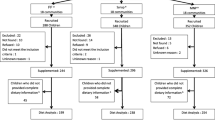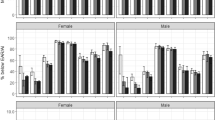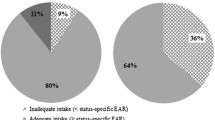Abstract
Objective: To estimate the potential of various industrially produced foods, to serve as a carrier for micronutrient fortification based on the frequency of their consumption in different socio-economic strata; to determine the role of fortified instant noodles as a source of micronutrients; to assess the contribution of plant foods, animal foods and fortified foods to vitamin A intake.
Setting: A survey was conducted in rural South Sulawesi and urban South Kalimantan between November 1996 and January 1997.
Subjects: Households (1500 in South Sulawesi; 2112 in South Kalimantan) were selected randomly by multi-stage cluster sampling. From each household, data were collected from the mother and her youngest child (0–5 y).
Data collection: Mothers were interviewed on various topics, including socio-economic status, food consumption, receipt of high-dose vitamin A capsules, health and nutritional status.
Results: Monosodium glutamate and salt were consumed daily in almost all households in both areas, and consumption was not associated with socio-economic status. Instant noodles were consumed in nearly all households in both areas, but consumption of fortified noodles was related to socio-economic status; it was highest among households of government employees and private investors, and lowest among farmers and share-croppers. Vegetables were the most important source of vitamin A in rural South Sulawesi, while foods of animal origin were the most important source in urban South Kalimantan.
Conclusions: The results support double or triple fortification of salt and/or monosodium glutamate with iodine, vitamin A and/or iron. Efforts to overcome associated technical and logistical difficulties are urgently needed.
Sponsorship: Opportunities for Micronutrient Interventions (OMNI); United States Agency for International Development (USAID).
European Journal of Clinical Nutrition (2000) 54, 822–827
Similar content being viewed by others
Author information
Authors and Affiliations
Contributions
Guarantor: Saskia de Pee.
Contributors: AMB carried out the data analysis and had the main part in writing the manuscript; SdP was involved in designing the survey and in editing and commenting on the manuscript; EM, SH and MS were involved in the design of the study, coordinated the data collection, and wrote the Subjects and methods section of the manuscript; SK, M and MWB had the final responsibility for the survey and gave overall comments on the manuscript.
Corresponding author
Rights and permissions
About this article
Cite this article
Melse-Boonstra, A., de Pee, S., Martini, E. et al. The potential of various foods to serve as a carrier for micronutrient fortification, data from remote areas in Indonesia. Eur J Clin Nutr 54, 822–827 (2000). https://doi.org/10.1038/sj.ejcn.1601094
Received:
Accepted:
Published:
Issue Date:
DOI: https://doi.org/10.1038/sj.ejcn.1601094
- Springer Nature Limited




